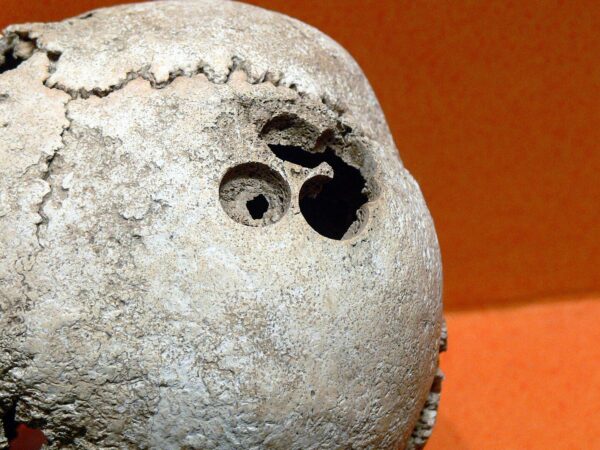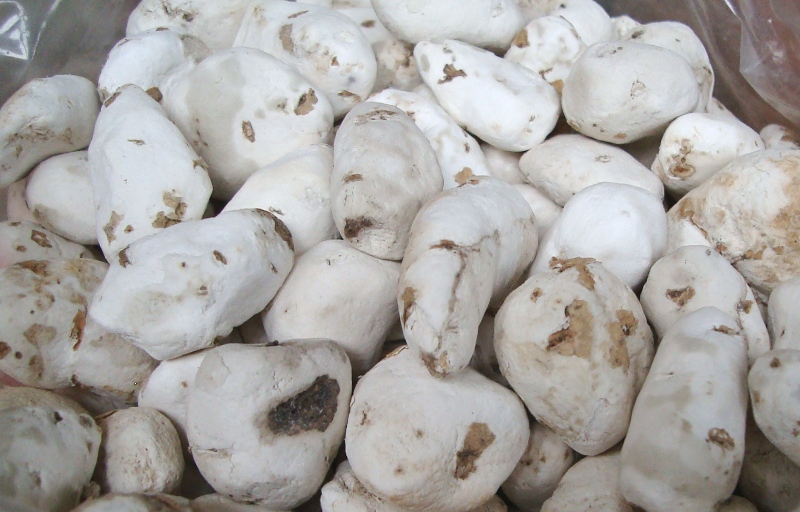Suka qullu, Chuño, Chullpas, and Trepanation.
Suka qullu:.
The Tiwanaku developed a distinctive farming method called suka qullu. Also known as flooded raised field agriculture, it involved creating artificially raised planting mounds that were then separated by shallow water-filled channels. The canals served a purpose beyond mere irrigation for growing crops. During the day they absorbed heat from solar radiation. When this heat rose off the surface during the bitterly cold nights, it provided thermal insulation against the endemic frost in the region effectively creating a greenhouse. There’s evidence that over time, the Tiwanaku used the canals to farm edible fish and dredged the resulting sludge to use as fertilizer.
(According to Alan Kolata’s book Valley of the Spirits, modern agricultural researchers have shown that while the method is labor intensive, it produces an average of 21 metric tons of potatoes per hectare compared to 14,500 tons using modern techniques complete with artificial fertilizers and pesticides, and only 2,400 tons per hectare using other regionally traditional techniques. A group of researchers led by archaeologist Clark Erickson, Peruvian agronomist Ignacio Garaycochea, anthropologist Kay Candler, and agricultural journalist Dan Brinkmeier re-introduced the suka qullu technique in the 1980s in the community of Huatta on the Peruvian side of Lake Titikaka with notable success. (If you’re interested, you canread more about it here.)
Chuño:
Thousands of years before they came to Ireland or France or the United States, potatoes were a staple of Andean food. In fact, the first potatoes were domesticated by Andean people some 10,000 years ago. As you can imagine, living at or above 4,000 meters means the winters will be long and harsh. Practices that allowed humans to survive and thrive in gentler climates were ineffective at these altitudes and in these climatic conditions. For the people who made their way to the high Andes, surviving meant adapting and one of those adaptations was inventing the chuño (sometimes called tunta) or freeze-dried potato.
The process begins in June in the Andean winter. For three or four days and nights potatoes are left in the open fields of the altiplano to freeze, thaw, and refreeze. In some instances, the potatoes are crushed underfoot to aid the dehydration process and subsequently left to dry in the sunlight to make black chuño. To make the more preferred white chuño, the potatoes are kept covered at all times. When they are close to fully dehydrated and hard enough, the next step is to place them in cages in the river. This slowly cleans them over a period that requires as long as 30 days.
When the potatoes are removed from the river, they are again left to freeze overnight. The next day they are peeled and washed then left to dry for another week in ichu – an Andean grass.
You might have learned that horses aren’t native to the Americas but arrived with the Spanish so the Andean people generally walked everywhere. With their water removed, the potatoes are light, easy to carry, and can be revived with a little water. Even more astonishingly, treated this way, the potatoes can be stored and eaten for up to a decade.
[Freeze dried potatoes. Photo from Perudelights.]
Chullpas:.
Simply put, a chullpa is an Andean funerary tower. (It is not in any way related to a chalupa so get your deep-fried mind out of your gut, er.) While we didn’t see a chullpa inside the museum, we did see examples of mummified corpses which were typically placed in a fetal position. As Berner would tell us, in the Andes, people don’t die. Rather, they move to a different cosmic sphere – of which there are three. For our guide at Tiwanaku, they are termed alax pacha, aka pacha and manaqha pacha.
Alax pacha is the upper realm or world above. This is all that’s visible in both the day and nighttime skies. It is symbolically represented by the condor. Aka pacha is the world inhabited by all perceptible living things and its symbol is the puma. Manaqha pacha is the inner world or the world below usually symbolized by a serpent though the Tiwanaku people may have also used a frog as their symbol. This realm is associated with both death and new life and these are the Aymara words. In his native Quechua, Berner would call them hanan pacha, kai pacha and ukhu pacha.
Because the Andean people see death as a transition, they place the corpse in a fetal position to signify its rebirth. It would be entombed with the tools it used in life so it could continue its work in the next realm and the only opening in the chullpa would face the rising sun in the east.
Trepanation:.

[Mesoamerican trepanated skull from Wikipedia By Wolfgang Sauber – Own work, CC BY-SA 3.0.]
While the idea of trepanation doesn’t fit neatly with the other three items, I bring it up because if you read the posts where I shared what I learned on my visit to the Coca Museum, you (I hope) learned a lot about coca leaves. In one of them I noted that the cocaine alkaloid was isolated by one Friedrich Gaedcke and that Karl Koller demonstrated its anesthetic effect in a somewhat gruesome way.
Trepanning, for those who don’t know, is the process of boring a hole in the skull and exposing the dura mater and it has been used for thousands of years. The earliest evidence in Europe was found at a burial site in France and dated to 6,500 BCE. Evidence indicates that pre-Inkan cultures also practiced this procedure. In their case, however, there is also evidence to support the idea that coca leaves were used as an anesthetic showing yet another deep connection between coca and the people populating the high Andes.
Now that we’ve learned a little about some of the survival and cultural practices of the Tiwanaku people, we can walk around the site and look at further physical manifestations of that culture.
